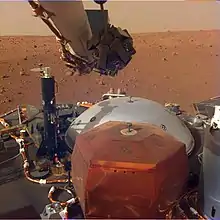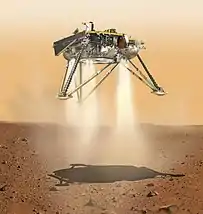Heat Flow and Physical Properties Package
The Heat Flow and Physical Properties Package (HP3) is a science payload on board the InSight lander that features instruments to study the heat flow and other thermal properties of Mars. One of the instruments, a burrowing probe nicknamed "the mole", is designed to penetrate 5 m (16 ft) below Mars' surface. In March 2019, the mole burrowed a few centimeters, but then became unable to make progress due to various scenarios. In the following year further efforts were made to resolve the issues.[2] On January 14, 2021, it was announced that efforts to drill into the martian surface using the device had been terminated.[3]
_(cropped).png.webp) Artist's impression of HP3 on the surface of Mars | |
| Operator | NASA |
|---|---|
| Manufacturer | German Aerospace Center (DLR) |
| Instrument type | infrared radiometer, thermal conductivity sensor |
| Function | Geophysics of Mars |
| Mission duration | 2 years on Mars (planned) |
| Began operations | Landing: 26 November 2018 |
| Website | mars |
| Properties | |
| Mass | 3 kg (6.6 lb) |
| Power consumption | 2 watts |
| Host spacecraft | |
| Spacecraft | InSight Mars lander |
| Operator | NASA |
| Launch date | 5 May 2018, 11:05 UTC |
| Rocket | Atlas V 401[1] |
| Launch site | Vandenberg SLC-3E[1] |
| COSPAR ID | 2018-042A |
HP3 was provided by the German Aerospace Center (DLR). The hammering mechanism inside the mole was designed by the Polish company Astronika and the Space Research Centre of the Polish Academy of Sciences under contract and in cooperation with DLR.[4][5]
The Principal Investigator is Tilman Spohn from the German Aerospace Center.[6][7]
Overview
The mission aims to understand the origin and diversity of terrestrial planets.[6] Information from the HP3 heat flow package is expected to reveal whether Mars and Earth formed from the same material, and determine how active the interior of Mars is today.[6][7][8][9] Additional science goals include determining the thickness of Mars' crust, the composition of its mantle, and thermal characteristics of the interior, such as the temperature gradient and heat flux.[10]
Together with the seismometer, the mission will estimate the size of Mars' core and whether the core is liquid or solid.[11] The vibrations generated by the mole will be monitored by SEIS to learn about the local subsurface.[12]
In addition to the mole, HP3 includes an infrared radiometer (HP3-RAD) mounted to the landing platform, also contributed by DLR.[13][14][15]

The HP3 heat flow probe is made up of the following subsystems:[16]
- Support Structure (SS) a housing that includes:
- Infrared radiometer (HP3-RAD) for measuring surface temperature.
- Back end electronics (BEE) electronic control unit
- Mole penetrometer for burrowing beneath the surface
- TEM-A active thermal conductivity sensor
- STATIL tiltmeter for determining orientation and direction of the mole.
Development
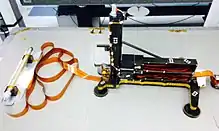
HP3 was conceived by Gromov V. V. et al. in 1997,[4][17] and first flown as the PLUTO instrument on the failed 2003 Beagle 2 Mars lander mission.[4] HP3 evolved further and it was proposed in 2001 for a mission to Mercury,[18] in 2009 to the European Space Agency as part of the Humboldt payload on board the ExoMars lander,[19][18] in 2010 for a mission to the Moon,[20] and in 2011 it was proposed to NASA's Discovery Program as a payload for InSight Mars lander, known at that time as GEMS (Geophysical Monitoring Station).[8] InSight was launched on 5 May 2018 and landed on 26 November 2018.
Mole penetrometer
The mole is described as a "self-hammering nail" and was designed to burrow below the Martian surface while trailing a tether with embedded heaters and temperature sensors. The goal is to measure the thermal properties of Mars' interior, and thus reveal unique information about the planet's geologic history.[4]
The burrowing mole is a pointed cylinder with a smooth outer surface approximately 35 cm (14 in) in length and 3.5 cm (1.4 in) in diameter. It contains a heater to determine thermal conductivity during descent, and it trails a tether equipped with precise heat sensors placed at 10 cm (3.9 in) intervals to measure the temperature profile of the subsurface.[6][7]
The mole penetrator unit is designed to be placed near the lander in an area about 3-m long and 2-m wide.[21] The total mass of the system is approximately 3 kg (6.6 lb) and it consumes a maximum of 2 watts while the mole is active.[7]
For displacement, the mole uses a motor and a gearbox (provided by Maxon) and a cammed roller that periodically loads a spring connected to a rod that functions as a hammer. After release from the cam, the hammer accelerates downwards to hit the outer casing and cause its penetration through the regolith. Meanwhile, a suppressor mass travels upwards and its kinetic energy is compensated by gravitational potential and compression of a brake spring and wire helix on the opposite side of the mole.[4]
In principle, every 50 cm (20 in) the probe puts out a pulse of heat and its sensors measure how the heat pulse changes with time. If the crust material is a thermal conductor, like metal, the pulse will decay quickly.[7] The mole is first allowed to cool down for two days, then it is heated to about 10 °C (50 °F) over 24 hours. Temperature sensors within the tether measure how rapidly this happens, which tells scientists the thermal conductivity of the soil.[22] Together, these measurements yield the rate of heat flowing from the interior.
The HP3 mole was originally expected to take about 40 days to reach 5 m (16 ft) deep.[23] As the mole burrows, it also generates vibrations that SEIS can detect, which may yield information about the Martian subsurface.[12]
Penetration efforts
In March 2019, the HP3 began burrowing into the surface sand, but became stalled after several centimeters by what was initially suspected to be a large rock.[24] Further analysis and testing with a replica model on Earth suggested the problem may be due to insufficient friction. In June 2019, more evidence for this was revealed when the support structure was lifted off of the HP3 mole. The Martian regolith appeared to be compressed, leaving a gap around the probe.
A technique was implemented using the lander's robotic arm to press on the soil near the probe to increase soil friction.[25][26][27][28] Ultimately, this method was not able to generate enough downward force, since the HP3 probe was at the limit of the arm's range.[28]
Instead, the team used the robotic scoop to pin the probe against the edge of its hole. This method appeared successful initially, as the probe continued to dig for two weeks, until it was flush with the surface.[29][30] At this time, the exposed top of the probe was too small for the scoop to press against, so the scoop was re-positioned to press down on the soil near the probe. Unfortunately, this caused the probe to back out again due to unusual soil properties and low atmospheric pressure.[31] As the probe bounced, loose soil filled the area beneath it and lifted the probe halfway out again.[32] In January 2020, the team used the pinning method again, but once again the probe ejected after the scoop was repositioned.[33]
In February 2020, the team reevaluated the risks of pushing the back cap of the mole directly using the robotic scoop, and determined the procedure to be acceptable. The procedure progressed slowly due to the requirement to reposition the scoop after each 1.5 cm of progress. In June 2020, the top of the mole reached the regolith surface.[34] The mole entered the surface at an angle of 30 degrees from vertical, but this angle may decrease if a greater depth is reached.[35]
In July 2020, it was revealed that the mole was bouncing in place, underneath the scoop, suggesting insufficient friction to continue digging. A proposed solution was to fill the hole with sand in order to distribute pressure from the robotic scoop, thereby increasing friction. This procedure was performed in early August 2020.[36]
In late August 2020, a test indicated positive results. The scoop applied a downward force to the sand which covered the mole while hammering strokes were performed. This test resulted in a few millimeters of progress,[37] and ultimately buried the instrument. In October 2020, the top of the mole was below the surface of Mars, and a decision was made to scrape two more scoops of regolith and tamp it down with the robotic scoop.[38] Hammering operations were scheduled to continue in January 2021.
Final attempts to get the probe deeper took place on 9 January 2021; after they proved unsuccessful, the decision was made to stop attempting to dig deeper. On January 14, 2021, NASA announced that, as the final attempt to bury the "mole" had failed, the team had given up, with the heat probe portion of the mission declared to be over. The lead scientist for the experiment, Tilman Spohn, said that, "Mars and our heroic mole remain incompatible." [39] The science team determined that the soil properties at the landing location were too different from what the instrument had been designed for. The team attempted many different remedies over several years to get the mole burrowing, but ultimately the attempts did not reach the target depth. The friction between the soil and the probe was not enough for the mole to hammer itself deeper.
The mole did achieve complete burial; the top of the mole is 2 to 3 centimetres below the Martian surface (with the mole itself being about 40 centimetres in length, the depth was thus about 43 centimetres). To be able to produce useful thermal measurements, the minimum required depth was specified as at least 3 metres deep.
Although unsuccessful, the mole's operations did teach the mission team a lot about the soil at the Insight site, about conducting excavation/drilling on Mars, and about operating the lander's robotic arm. The mole-rescue effort that used the arm in ways that were unplanned before the mission. The seismometer (SEIS), radio experiment (RISE) and the weather instruments (TWINS) continue to operate as the lander's Mars surface mission was extended by two years, until the end of December 2022. [40]
- Efforts of HP3 to penetrate the Martian surface
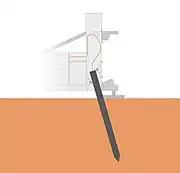 Engineering analysis of the mole after the initial problem concluded that the bottom of the mole was about 12–14 inches (30–36 cm) deep into Martian ground, with a bit of its top still inside the HP3 support structure.
Engineering analysis of the mole after the initial problem concluded that the bottom of the mole was about 12–14 inches (30–36 cm) deep into Martian ground, with a bit of its top still inside the HP3 support structure.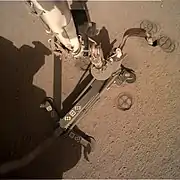 Insight's HP3 components after lifting the support structure away from the mole. This image shows a region of compressed regolith around the Mole penetrometer.
Insight's HP3 components after lifting the support structure away from the mole. This image shows a region of compressed regolith around the Mole penetrometer.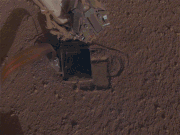 The initial success of the pinning technique is depicted in this time lapse video, which shows the probe burrowing into the regolith.
The initial success of the pinning technique is depicted in this time lapse video, which shows the probe burrowing into the regolith. HP3 is seen after backing about halfway out of the hole it had burrowed.
HP3 is seen after backing about halfway out of the hole it had burrowed. Insight lander using its scoop to push on the back cap of the HP3 mole.
Insight lander using its scoop to push on the back cap of the HP3 mole.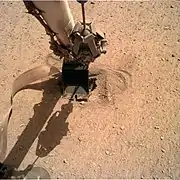 HP3 mole at the surface of Mars, with the lander scoop pressing on its back cap.
HP3 mole at the surface of Mars, with the lander scoop pressing on its back cap.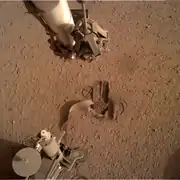 The mole, after being covered with sand by the robotic scoop
The mole, after being covered with sand by the robotic scoop Mars InSight Lander - "Mole" - Final Efforts
Mars InSight Lander - "Mole" - Final Efforts
(9 January 2021)
HP3-RAD Infrared Radiometer
The HP3 includes an infrared radiometer for measuring surface temperatures, contributed by DLR and based on the MARA radiometer for the Hayabusa2 mission.[13][14][15] HP3-RAD uses thermopile detectors to measure three spectral bands: 8–14 μm, 16–19 μm and 7.8–9.6 μm.[41] HP3-RAD has a mass of 120 g (4.2 oz).[41]
The detector was protected by a removable cover during landing.[41] The cover also serves as a calibration target for the instrument, supporting on-site calibration of the HP3-RAD.[41]
Infrared radiometers were sent to Mars in 1969 as one of four major instruments on the Mariner 6 and Mariner 7 flyby spacecraft, and the observations helped to trigger a scientific revolution in knowledge about Mars.[42][43] The Mariner 6 & 7 infrared radiometer results showed that the atmosphere of Mars is composed mostly of carbon dioxide (CO2), and revealed trace amounts water on the surface of Mars.[42]
See also
- Mini-TES, an infrared instrument on the 2003 Mars Exploration Rovers
References
- Clark, Stephen (19 December 2013). "Mars lander to launch from California on Atlas 5 in 2016". Spaceflight Now. Retrieved 20 December 2013.
- "NASA Uses InSight's Robotic Arm to Push Heat Probe Into Mars - ExtremeTech". www.extremetech.com. Retrieved 22 March 2020.
- Dunn, Marcia (14 January 2021). "RIP: Mars digger bites the dust after 2 years on red planet". Associated Press. Retrieved 14 January 2021.
- Hammering Mechanism for HP3 Experiment (InSight). (PDF) Jerzy Grygorczuk1, Łukasz Wiśniewski1, Bartosz Kędziora1, Maciej Borys, Rafał Przybyła1, Tomasz Kuciński1, Maciej Ossowski, Wojciech Konior, Olaf Krömer, Tilman Spohn, Marta Tokarz and Mateusz Białek. European Space Mechanisms and Tribology Symposium; 2016.
- "Polish Kret will fly to Mars". Science in Poland. Retrieved 5 May 2018.
- Banerdt, W. Bruce (2012). InSight – Geophysical Mission to Mars (PDF). 26th Mars Exploration Program Analysis Group Meeting. 4 October 2012. Monrovia, California.
- "Heat Probe | Instruments". NASA's InSight Mars Lander. Retrieved 13 April 2020.
- Grott, M.; Spohn, T.; Banerdt, W. B.; Smrekar, S.; Hudson, T. L.; et al. (October 2011). Measuring Heat Flow on Mars: The Heat Flow and Physical Properties Package on GEMS (PDF). EPSC-DPS Joint Meeting 2011. 2–7 October 2011. Nantes, France. Bibcode:2011epsc.conf..379G. EPSC-DPS2011-379-1.
- Agle, D. C. (20 August 2012). "New Insight on Mars Expected From new NASA Mission". NASA.
- mars.nasa.gov. "Goals | Science". NASA's InSight Mars Lander. Retrieved 3 September 2019.
- Kremer, Ken (2 March 2012). "NASAs Proposed 'InSight' Lander would Peer to the Center of Mars in 2016". Universe Today. Retrieved 27 March 2012.
- mars.nasa.gov. "Surface Operations | Timeline". NASA's InSight Mars Lander. Retrieved 24 December 2018.
- Banerdt, W. Bruce (7 March 2013). InSight: A Geophysical Mission to a Terrestrial Planet Interior (PDF). Committee on Astrobiology and Planetary Science. 6–8 March 2013. Washington, D.C.
- "InSight: In Depth". Solar System Exploration. NASA. Retrieved 2 February 2018.
- Grott, M.; et al. (July 2017). "The MASCOT Radiometer MARA for the Hayabusa 2 Mission". Space Science Reviews. 208 (1–4): 413–431. Bibcode:2017SSRv..208..413G. doi:10.1007/s11214-016-0272-1. S2CID 118245538.
- "HP3 heat flow probe". DLR Portal. Retrieved 4 June 2020.
- Gromov V.V. et al.: The mobile penetrometer, a "mole" for sub-surface soil investigation. In Proc. of 7th European Space Mechanisms and Tribology Symposium. 1997.
- A heat flow and physical properties package for the surface of Mercury. Tilman Spohn, Karsten Seiferlin. Planetary and Space Science 49(14-15):1571-1577 December 2001. doi:10.1016/S0032-0633(01)00094-0
- HP3 on ExoMars. Krause, C.; Izzo, M.; Re, E.; Mehls, C.; Richter, L.; Coste, P. EGU General Assembly 2009, held 19–24 April 2009 in Vienna, Austria.
- Measuring heat flow on the Moon — The Heat Flow and Physical Properties Package HP3. (PDF) T. Spohn, M. Grott L. Richter, J. Knollenberg, S.E. Smrekar, and the HP3 instrument team. Ground-based Geophysics on the Moon (2010). Lunar and Planetary Institute, conference 2010.
- "Instruments Deployment - SEIS / Mars InSight". www.seis-insight.eu. Retrieved 26 December 2018.
- "NASA's InSight Prepares to Take Mars' Temperature". NASA/JPL. 13 February 2019. Retrieved 13 April 2020.
- "Surface Operations". NASA's InSight Mars Lander. Retrieved 13 April 2020.
- Dickinson, David (11 March 2019). "Mars Insight's "Mole" Hits a Snag". Sky & Telescope. AAS Sky Publishing, LLC. Retrieved 1 September 2019.
- Dickinson, David (3 July 2019). "A Strategy to Get the Mars Insight Lander Back in the Drilling Business". Sky & Telescope. AAS Sky Publishing, LLC. Retrieved 31 August 2019.
- "NASA's InSight Uncovers the 'Mole'". NASA/JPL. Retrieved 31 August 2019.
- Dvorsky, George. "Here's How NASA Might Rescue InSight's Extremely Stuck Heat Probe". Gizmodo. Retrieved 4 October 2019.
- Gough, Evan (18 October 2019). "Success! NASA Confirms the Mole is Working Again". Universe Today. Retrieved 19 October 2019.
- Kooser, Amanda. "NASA Mars lander may be able to save its stuck 'mole'". CNET. Retrieved 14 October 2019.
- Greicius, Tony (17 October 2019). "Mars InSight's 'Mole' Is Moving Again". NASA. Retrieved 19 October 2019.
- mars.nasa.gov. "Mars InSight's Mole Has Partially Backed Out of Its Hole". NASA's InSight Mars Lander. Retrieved 28 October 2019.
- Palca, Joe (29 November 2019). "A 'Mole' Isn't Digging Mars: NASA Engineers Are Trying To Find Out Why". NPR.org. Retrieved 29 November 2019.
- "InSight to try to push mole into Martian surface". SpaceNews.com. 21 February 2020. Retrieved 25 February 2020.
- Spohn, Tilman (3 June 2020). "The InSight mission logbook". DLR Blogs. Retrieved 4 June 2020.
- "InSight mole making slow progress into Martian surface". SpaceNews.com. 5 May 2020. Retrieved 7 May 2020.
- Spohn, Tilman (10 August 2020). "Mars InSight mission: The Mole is 'in' and the 'finishing touches' are 'in sight'". DLR Blogs. Retrieved 7 September 2020.
- "NASA's Insight Mars lander rescue operation makes progress saving 'stuck' probe | TESLARATI". www.teslarati.com. Retrieved 17 September 2020.
- Gough, Evan (16 October 2020). "InSight's 'Mole' is Now Completely buried!". Universe Today. Retrieved 19 October 2020.
- Dunn, Marcia (14 January 2021). "RIP: Mars digger bites the dust after 2 years on red planet". Associated Press. Retrieved 14 January 2021.
- "NASA InSight's 'Mole' Ends Its Journey on Mars". Jet Propulsion Laboratory. 14 January 2021. Retrieved 15 January 2021.
- Kopp, Emanuel; Mueller, Nils; Grott, Matthias; Walter, Ingo; Knollenberg, Jörg; Hanschke, Frank; Kessler, Ernst; Meyer, Hans-Georg (1 September 2016). Strojnik, Marija (ed.). "HP3-RAD: a compact radiometer design with on-site calibration for in-situ exploration" (PDF). Infrared Remote Sensing and Instrumentation Xxiv. 9973: 99730T. Bibcode:2016SPIE.9973E..0TK. doi:10.1117/12.2236190. S2CID 125699932.
- "Infrared Spectrometer and the Exploration of Mars". American Chemical Society. Retrieved 26 December 2018.
- Chdse, S. C. (1 March 1969). "Infrared radiometer for the 1969 mariner mission to Mars". Applied Optics. 8 (3): 639. doi:10.1364/AO.8.000639. ISSN 1559-128X. PMID 20072273.


